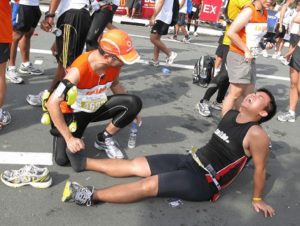Do you remember your grandpa jumping out of his chair in front of the TV yelling, “Charley Horse!” and “Leg Cramp – It’s A Doozy!”
As he thrashed on the floor, he begged for someone to massage his legs deeply until the cramp subsided.
Leg cramps are humiliating and extremely painful!
I’ve seen top-level athletes (football players) reduced to tears on camera in front of millions of people, because of the pain.
You have probably experienced flying out of bed in the middle of the night, grinding your teeth as you dance the leg spasm away, hoping no one is YouTube-ing it.
We have all been there. There simply is no way to dismiss the pain.
And because leg spasms are not uncommon, people ask me as a massage therapist, “will massage help?”
Will deep tissue massage help leg cramps?
Before we answer that question we must dissect what causes the spasms in the first place.
The number one cause of cramping in the lower leg is dehydration.
Sports doctors cannot emphasize enough the need for water in keeping this tragedy from happening on the field.
It also is a serious problem at work stations and managers are always riding their employees to stay hydrated. Hydrated employees mean less Worker’s Comp cases.
Water allows many wonderful things to happen in our muscles. It helps flush metabolic waste (uric and lactic acid).
It brings cellular nutrition to muscle spindles (nerves responsible for muscle length) and golgi tendon organs (nerves responsible for tension on the tendon).
Without hydration, the muscle spindles will protect the muscle from dying by forcing you to the ground crying like a baby.
Muscle spindles activate a counter-stretch response to contract the muscle during exercise, but can also be used to maintain a deeper and longer contraction (spasm).
The number two reason for Charley Horses is mineral deficiency.
Minerals such as magnesium, calcium, sodium, and the big one – potassium, play a major role in muscle health.
As personal trainers, we would always tell our clients, “An avocado a day will keep the spasms away.”
They are the highest form of potassium.
The third reason for grabbing your leg like it is trying to run away is: exercise intensity and overuse.
There is only so much your muscles are going to put up with before they spank you.
Long duration exercise brakes down muscle fibers to a point that they cannot recoup in time.
Once the tissue damage reaches that certain threshold the brain sends signals to shut that compartment down.
Thus the picture of the athlete on his butt:
Last, but not least, is Number Four. Sitting on your rump all day.
Sitting or laying for long periods can cut off blood supply to your muscles.
Thus, Grandpa is break-dancing on the floor before it was popular to do so.
That La-Z-Boy chair is what got him.
So why do we get cramps at night while sleeping?
The theory as to why we cramp at night while doing nothing but singing Zzzz’s is that, while lying down, blood supply is being hindered to the lower legs and thus the nerves scream for blood.
“Wake UP!” they say. “Move, move, move”. And you comply.
And that pretty much sums up the top four reasons.
There also can be medical problems associated with medications or autoimmune diseases that causes cramps, but that is outside the massage therapist’s realm of expertise.
Well, now we have an idea of the why we get them; how about we answer “will massage help?”
Yes! It majorly helps!
How to massage legs that cramp?
The soleus, gastrocnemius and plantaris muscles make up the achilles tendon.
When the leg cramps, we don’t know which muscle is cramping. So, it matters how we stretch and perform deep tissue massage, because of their synergistic responsibilities. We suggest looking into lizzardco.com to learn how to stretch properly.
Example: If the postural muscle (the soleus) is tight, it takes a whole lot more effort on the massage therapist to correct as compared to the gastrocnemius (phasic).
The best advice I have is to start with the gastrocnemius (the most superficial muscle of lower leg) with light palm strokes from the heel to the popliteus muscle (space behind knee cap).
Once that phasic muscle (fast-twitch fibers) is loose, then work on the deeper muscle (slow-twitch fibers) soleus, by using crossing strokes (lateral to medial) with the forearm, all the way from heel to popliteal space.
The plantaris muscle is worked along with the soleus so no special technique is needed for it.
Do this regularly and stay hydrated and your chances of the calf muscles cramping will be minimized.
But, why am I telling you this. You don’t care. You just want me to fix you without the mumbo-jumbo.
Got it!
Book a visit with me and let’s get those leg spasms to end.
Doug Holland, LMT
Cortland, Ohio
330-637-3056

